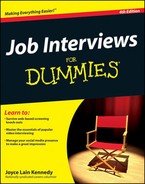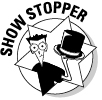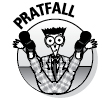Introduction
If you’d rather fight off an alien invasion than be grilled in an interview, take heart — you’ve come to the right guidebook. With the help of dozens of interviewing authorities, I make your interviewing challenge easy, successful, and even fun (steal a peek at the last chapter).
I share with you lots of new things in this fourth edition of Job Interviews For Dummies, ranging from the cosmic shift sparked by the rise of social media that changes what privacy means, to increasingly popular video interviewing that changes how communication occurs.
What hasn’t changed is the fundamental role in the employment process played by job interviews — those crucial meetings that seal the deal on who gets hired and who gets left on the outside looking in.
So on with the show! With the help of this guidebook, you, too, can be a ShowStopper.
What Exactly Is a ShowStopper in Job Interviewing?
In the drama of job interviewing, a ShowStopper performance is one that wins so much enthusiastic, prolonged applause that the show is temporarily interrupted until the audience quiets down.
A ShowStopper meeting causes the interviewer to mentally shout, “Bravo! More!” Your stunning impact quickly translates to a preliminary decision in your favor. If follow-up interviews, testing, and reference checking support that reaction, a job offer is on its way to you. The employer may continue to see other candidates to round out the interview process, but in reality, no one else stands a chance of landing the job after you figuratively stop the show.
Job Interviews For Dummies is packed with the essentials of performing ShowStopper interviews:
![]() Strategies and techniques
Strategies and techniques
![]() Sample dialogue and research tips
Sample dialogue and research tips
![]() The best answers to make-or-break questions
The best answers to make-or-break questions
About This Book
A guidebook of contemporary interview arts, Job Interviews For Dummies contains the distilled wisdom of hundreds of leading interview experts whose brains I’ve been privileged to pick for many years. By absorbing the guidance and tips I pass on in this guide, you can interview your way into a job by outpreparing and outperforming the other candidates.
Conventions Used in This Book
To assist your navigation of this guidebook, I’ve established the following conventions:
![]() I use italic for emphasis and to highlight either new words or terms I define.
I use italic for emphasis and to highlight either new words or terms I define.
![]() Web addresses appear in a special font to distinguish them from the regular type in the paragraph.
Web addresses appear in a special font to distinguish them from the regular type in the paragraph.
![]() Sidebars, which are shaded boxes of text, consist of information that’s interesting but not necessarily critical to your understanding of the topic.
Sidebars, which are shaded boxes of text, consist of information that’s interesting but not necessarily critical to your understanding of the topic.
Terms Used in This Book
Is there another word for synonym? Would a fly without wings be called a walk? How is it possible to have a civil war? These one-liners from comedian George Carlin (www.georgecarlin.com) hint at the importance of words.
I use the following terminology in this guide to label specific roles and organizations:
![]() A candidate or job seeker is a person applying for a job. (Another once-common label, applicant, is used less today because of a federal regulation that defines an applicant as one to be counted in discrimination monitoring. But applicant means the same thing.)
A candidate or job seeker is a person applying for a job. (Another once-common label, applicant, is used less today because of a federal regulation that defines an applicant as one to be counted in discrimination monitoring. But applicant means the same thing.)
![]() An interviewer is someone interviewing a candidate for a job. An interviewee is a candidate being interviewed for a job.
An interviewer is someone interviewing a candidate for a job. An interviewee is a candidate being interviewed for a job.
![]() A human resources (or HR) specialist, HR manager, or screener is an employer sentry who is conducting a screening (preliminary) interview.
A human resources (or HR) specialist, HR manager, or screener is an employer sentry who is conducting a screening (preliminary) interview.
A hiring manager, hiring authority, decision maker, decision-making manager, or department manager is a management representative who is conducting a selection interview and who has the authority to actually hire a person for a specific position. (Read about the differences in screening and selection interviews in Chapters 2 and 5.)
![]() A company, employer, or organization is the entity you hope to work for, whether private and profit-making, or private and nonprofit. Agency implies employment in the government (public) sector.
A company, employer, or organization is the entity you hope to work for, whether private and profit-making, or private and nonprofit. Agency implies employment in the government (public) sector.
![]() A recruiter (also called a headhunter) is an intermediary between the employer and you. Internal recruiters work inside the company, either as regular employees of the human resources department or as contract employees. Third-party recruiters or independent recruiters are external recruiters, some of whom are employed as retained recruiters on an ongoing basis, while most are employed on a transaction basis as contingency recruiters and are paid only when a candidate they submit is hired.
A recruiter (also called a headhunter) is an intermediary between the employer and you. Internal recruiters work inside the company, either as regular employees of the human resources department or as contract employees. Third-party recruiters or independent recruiters are external recruiters, some of whom are employed as retained recruiters on an ongoing basis, while most are employed on a transaction basis as contingency recruiters and are paid only when a candidate they submit is hired.
![]() A career coach (also called a career consultant) helps job seekers gain workplace opportunities. (A career counselor and a career coach represent two different professions, although their work sometimes overlaps.)
A career coach (also called a career consultant) helps job seekers gain workplace opportunities. (A career counselor and a career coach represent two different professions, although their work sometimes overlaps.)
![]() A hiring professional is any of the aforementioned professionals who is engaged internally or externally in the employment process.
A hiring professional is any of the aforementioned professionals who is engaged internally or externally in the employment process.
Foolish Assumptions
I assume you picked up this book for one of the following reasons:
![]() You’ve never been through a competitive interview and you’re freaking out. You need a couple thousand friendly pointers from someone who’s interviewed many of the marquee minds in the job interview business and lived to write about it.
You’ve never been through a competitive interview and you’re freaking out. You need a couple thousand friendly pointers from someone who’s interviewed many of the marquee minds in the job interview business and lived to write about it.
![]() You’ve been through a competitive interview and assume the company sank like Atlantis because you never heard a peep from those folks again. Or maybe you could have done better and actually heard back if you’d have known more about what you were doing in this interview thing.
You’ve been through a competitive interview and assume the company sank like Atlantis because you never heard a peep from those folks again. Or maybe you could have done better and actually heard back if you’d have known more about what you were doing in this interview thing.
![]() The most important interview of your career is coming up. You realize that now is the hour to dramatically improve your interviewing success. You need help, and you’re willing to learn and work for success.
The most important interview of your career is coming up. You realize that now is the hour to dramatically improve your interviewing success. You need help, and you’re willing to learn and work for success.
![]() You’ve been through a slew of job interviews over the course of your career and have a hunch that some important things have changed (you just don’t know what exactly). You want to catch up with the help of a trusted resource.
You’ve been through a slew of job interviews over the course of your career and have a hunch that some important things have changed (you just don’t know what exactly). You want to catch up with the help of a trusted resource.
![]() You want to be in the interviewing know and are sure that the authors of For Dummies books will give you the goods. You rely on For Dummies books to get the facts you need to succeed without jumping through verbal hoops until your eyes pop out of your head.
You want to be in the interviewing know and are sure that the authors of For Dummies books will give you the goods. You rely on For Dummies books to get the facts you need to succeed without jumping through verbal hoops until your eyes pop out of your head.
I further assume that you’re someone who likes reliable, comprehensive information that gets to the point without rocking you to sleep. And I assume even further that you like your expertise with a smile now and then.
How This Book Is Organized
Before he was famous, superstar George Clooney auditioned for a television stereo commercial with a six-pack of beer tucked under his arm; he had researched the type of actor the advertiser wanted for the role, one whose attitude revealed the casual poise of a couch potato. He got the gig.
Later, Clooney explained the contribution of performance in both theatrical auditioning and job interviewing. He noted that the actor who lands the job isn’t always the most talented, but the one who makes the best impression: “You get the job when you walk in the door. Because in a weird way, we’re not selling acting. What we’re selling is confidence.”
Appearance. Performance skills. Confidence. All are winning — and learnable — traits in job interviews as well as theatrical auditions. This guidebook shows you these traits and much, much more in the following five useful categories.
Part I: And the Interview Winner Is . . . You!
This part opens with an overview of what’s happening right now in job interviewing circles, beginning with the theme of this guidebook: Interviews are theater. A spotlight on new topics is next, including the growing impact of screening interviews, the spread of video interviewing, and interesting interview variations in a global marketplace. The conclusion is a review of 18 formats you may encounter, from behavior-based interviews to mealtime interviews.
Part II: Backstage Researching and Rehearsing
In this part, I show you how to explore the backstage preparation that drives interview success. You learn how to research employers, understand personality tests, negotiate salary, dress like a star, overcome stage fright, look smart with questions you ask, and say all the right things to hold the door open to gracefully check back with the interviewer for progress reports on filling the job.
Part III: Actors’ Studio: Casting Your Character
Are you a new graduate who’s getting ready for your debut career interview and concerned about coming across as a clueless beginner? An experienced person who feels miscast and wants desperately to change careers? A job-search veteran whose presentation persona may need a touch-up? I show you how to tailor your interviews for job offers, whether you’re a rookie, career refugee, or prime-timer.
Part IV: Lights, Camera, Talk! Answering Questions
How do you deal with the heart and soul of the interview, the questions? Turn to this part to find out. Here you immediately discover how to deliver a ShowStopper’s response to each major question employers are almost certain to ask. I present the answers in a crisp style that puts you far ahead of your competitors.
Part V: The Part of Tens
Be ready to bag quick, surefire tips that help you put a five-star shine on your performance. You’ll also learn how to avoid falling through trapdoors with the wrong answers to trick questions. As you leave the stage triumphantly, take a few minutes to smile as you read an irreverent group of statements that superstars of history may have made on a job interview, if they’d had one.
Icons Used in This Book
For Dummies signature icons are the little round pictures you see in the margins of the book. I use them to focus a searchlight on key bits of information. Here’s a list of the icons you find in this book:
Where to Go from Here
On the stress scale of life, job interviewing ranks with making a speech before 500 people when you can’t remember your name or why you’re standing in a spotlight at a podium. The spot where you start in this guidebook book depends on your present needs:
![]() When you have a job interview tomorrow, quickly read Chapter 1 for an overview, followed by Chapters 23 and 24 for an instant infusion of key know-how. Additionally, go to the company’s website to glean as much basic information as you can. Don’t forget to read the company’s press releases.
When you have a job interview tomorrow, quickly read Chapter 1 for an overview, followed by Chapters 23 and 24 for an instant infusion of key know-how. Additionally, go to the company’s website to glean as much basic information as you can. Don’t forget to read the company’s press releases.
![]() When you have a few days before you’re scheduled for an interview, read Chapter 1 and then flip through the Table of Contents to the chapters dealing with your most pressing concerns. Pay attention to Chapter 12, which reveals how to stack the deck in your favor during the closing minutes of your interview.
When you have a few days before you’re scheduled for an interview, read Chapter 1 and then flip through the Table of Contents to the chapters dealing with your most pressing concerns. Pay attention to Chapter 12, which reveals how to stack the deck in your favor during the closing minutes of your interview.
![]() When you have plenty of time, read the book from cover to cover. Practice recommended strategies and techniques. After you master the information in these pages, you’ll have a special kind of insurance policy that pays big dividends for as long as you want to work.
When you have plenty of time, read the book from cover to cover. Practice recommended strategies and techniques. After you master the information in these pages, you’ll have a special kind of insurance policy that pays big dividends for as long as you want to work.




